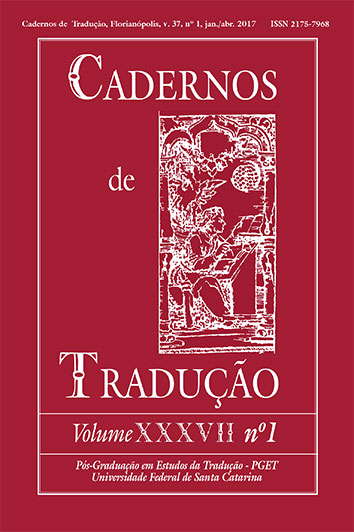Language, silence and translation in Emanuele Crialese’s polyglot migration film Nuovomondo – Golden Door (2006)
DOI:
https://doi.org/10.5007/2175-7968.2017v37n1p119Abstract
This essay aims to examine various aspects of Emanuele Crialese’s Nuovomondo – Golden Door (Italy-France, 2006), with particular attention given to the use of multiple languages (English, Italian and Sicilian dialect) in this migration film, and to their subtitle translation for the DVD version of the film. The language interplay in Nuovomondo raises a series of questions concerning the possibility – and impossibility – of translating culturally bound material from a polyglot multi-semiotic product into another language/culture. Assuming the transnational importance of this film as an epitome of cultural (un)translatability, this essay will scrutinize and enlarge on a series of questions relating to the role of language, silence and translation. The film represents a perfect example of how language played a crucial role in defining power relationships between migrants and Americans at the “(un)welcoming” harbor in the twentieth century. It also raises questions on how forms of inclusion, subversion and legitimation were articulated in a dominant culture – such as that of the US – in response to otherness, and on the role of translation also as an exercise of power and identity (re)negotiation.
Riferimenti bibliografici
Appadurai, Arjun. Modernity at Large: Cultural Dimensions of Globalization. Minneapolis and London: University of Minnesota Press, 1996.
Berger, Verena; Komori, Miya. (eds.) Polyglot Cinema: Migration and Transcultural Narration in France, Italy, Portugal and Spain. Wien: Lit Verlag, 2010.
Bhabha, Homi. The Location of Culture. London and New York: Routledge, 1994.
Cronin, Michael. Translation Goes to the Movies. London and New York: Routledge, 2009.
______. Across the Lines. Travel, Language, Translation. Cork: Cork University Press, 2000.
______. Translation and Identity. London: Routledge, 2006.
De Meo, Mariagrazia. Subtitling Dialect and Culture-bound Language. Roma: Carocci, 2010.
Díaz Cintaz, Jorge; Remael, Aline. Audiovisual Translation: Subtitling. London and New York: Routledge, 2007.
Kral, Françoise. “Du silence du polyglotte au bégaiement de la langue: vacillations et errances de la voix diasporique.” Questions de Voix, Tropismes 17 (2011). Available at <http://ojs.u-paris10.fr/index.php/tropismes/article/view/120/195>.
Kristeva, Julia. Strangers to Ourselves. New York: Columbia University Press, 1991.
Mamula, Tijana. Cinema and Language Loss. Displacement, Visuality and the Filmic Image. London and New York: Routledge, 2013.
Marubbio, M. Elise. Killing the Indian Maiden: Images of Native American Women in Film. Lexington: University Press of Kentucky, 2006.
Moretti, Enrico. “Social Networks and Migrations: Italy 1876-1913.” The International Migration Review 33.3 (1999): 640-657.
Ortega, Elena S. “Subtitling and the Relevance of Non-verbal Information in Polyglot Films.” New Voices in Translation Studies 7 (2011): 19-34.
Pethö, Agnes. Cinema and Intermediality: The Passion for the In-Between. Newcastle upon Tyne: Cambridge Scholars Publishing, 2011.
Polezzi, Loredana. “Translation and Migration.” Translation Studies 5 (2012): 345-356.
Roediger, David. Working Towards Whiteness. How America’s Immigrants Became White. New York: Basic Books, 2005.
Taronna, Annarita. Translationscapes. Comunità, lingue e traduzioni interculturali. Bari: Progedit, 2009.
Wagner, Peter. (ed.) Icons, Texts, Iconotexts. Essays on Ekphrasis and Intermediality. Berlin: De Gruyter, 1996.
Zaccaria, Paola. “Ripresa (cine)fotografica e/o come traduzione: il caso Nuovo Mondo.” In Capano Perrone, Lucia (ed.), Il testo oltre i confini. Paesaggi, scambi, migrazioni. Bari: Palomar, 2009. 173-203.
##submission.downloads##
Pubblicato
Come citare
Fascicolo
Sezione
Licenza
Autores têm autorização para assumir contratos adicionais separadamente, para distribuição não exclusiva da versão do trabalho publicada nesta revista (ex.: publicar em repositório institucional ou como capítulo de livro, com reconhecimento de autoria e publicação inicial nesta revista).





















































